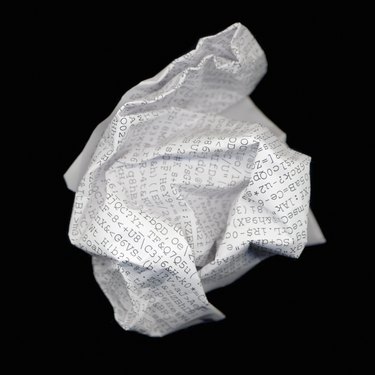
Paper that is crumpled, curled or rolled need not stay that way forever. If your project requires flat, smooth paper, several techniques, such as ironing or rubbing the paper over the edge of a table, render it smooth once again. The ideal method for the paper depends on its durability.
Steam-Room Treatment
Video of the Day
Flatten the paper on a table, using your hands to smooth out as many of the creases and wrinkles as possible. Place the paper atop a surface such as a sheet of corrugated cardboard or, ideally, a non-metal window screen, which allows for sufficient airflow. Set the paper atop the cardboard or screen in a bathroom, away from the shower. Close the windows and doors and turn on the shower on the hottest water setting so the room becomes humid. Close the shower curtain to prevent splashes. Turn the water off after 5 to 10 minutes; then take the paper to another room. Sandwich the paper between two flat cardboard sheets, using heavy objects to weigh the cardboard down. Remove the paper after a day or so.
Video of the Day
A Touch of Water
For crumpled paper that will not be damaged by slight moisture, such as a letter written in pencil on copy paper or a photocopy of an invoice, smooth the paper out as much as possible with your hands while the paper rests on a flat, clean surface. Wet an absorbent white tea towel or microfiber cloth, wringing out as much moisture as possible. Lightly wipe the paper with the damp cloth; then sandwich the paper between two sheets of corrugated cardboard, glass or plywood -- any smooth, flat and clean objects will do. Place a heavy object such as a stack of thick books atop the paper "sandwich," removing the paper after a day or two. Test a corner of your paper first if you're unsure whether moisture may harm it, or test the water on a piece of similar paper before using it on the actual crumpled paper.
Flattening Rolled Paper
Paper kept rolled up for a long time, such as a map, poster or blueprint, has a tendency to stay curled even after you unroll it. Help the paper lie flat again by rolling the paper in the opposite direction of the curl. Place a rubber band loosely around the paper and let the paper sit for at least 20 minutes before unrolling it. Often, this is enough to relax the paper fibers so the paper lies flat on its own again. If this doesn't do the trick create a chamber using two plastic tubs, one large enough to hold the rolled paper, and one large enough to hold the first tub with room to spare. Pour an inch or so of warm water into the largest tub; set the smaller tub in it. Place the paper inside the small tub, ensuring no water touches it. Cover the small tub with plastic wrap and secure the lid on the larger tub. After a day or two, remove the rolled paper from the inner tub, sandwich it between two smooth, flat objects; then weigh them down with heavy books. After another day or two, the rolled paper should be flat.
Iron Assistance
If you need the paper to lie flat but don't have the time to wait several days, a clothes iron helps -- if used with care and caution. Place the paper atop a sheet of corrugated cardboard slightly larger than the paper itself. Smooth the paper out as much as possible with your hands. Mist a small amount of water onto a white cloth such as a piece of linen or canvas; then place another sheet of paper atop the wrinkled paper. Set the damp cloth atop the papers, then iron the cloth on a low-heat setting, moving the iron frequently. Check the wrinkled paper after a minute or so and stop ironing once it lies flat.
Special Considerations
Do not use moisture-based methods to treat valuable art pieces or paper that has some value to you, as the paper can be damaged during the process if it gets too wet. In the same manner, don't apply moisture to paper printed with regular ink-jet computer printer ink, as the ink may bleed. Pastels, chalks and watercolors also should not be treated with moisture. Thin tinted paper such as tissue paper may bleed if wet, and tissue paper in general is too fragile to handle moisture.